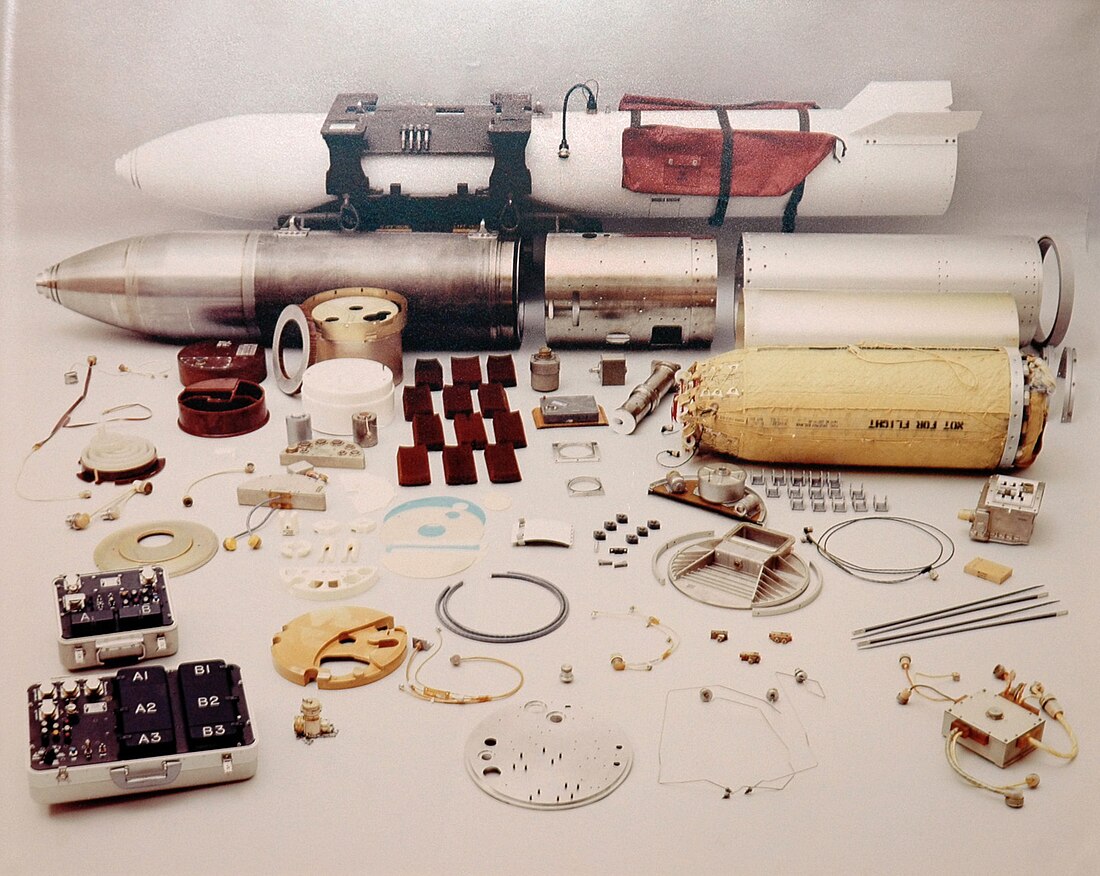B83 nuclear bomb
American thermonuclear gravity bomb From Wikipedia, the free encyclopedia
The B83 is a variable-yield thermonuclear gravity bomb developed by the United States in the late 1970s that entered service in 1983. With a maximum yield of 1.2 megatonnes of TNT (5.0 PJ), it has been the most powerful nuclear weapon in the United States nuclear arsenal since October 25, 2011 after retirement of the B53.[1] It was designed by Lawrence Livermore National Laboratory.[2]
| B83 | |
|---|---|
 B83 with unclassified components at front | |
| Type | Unguided bomb |
| Service history | |
| In service | 1983-2025? |
| Used by | United States |
| Production history | |
| Designer | Lawrence Livermore National Laboratory |
| No. built | 650 |
| Specifications | |
| Mass | 2,400 pounds (1,100 kg) |
| Length | 12 feet (3.7 m) |
| Diameter | 18 inches (46 cm) |
| Blast yield | 1.2 megatonnes of TNT (5.0 PJ) |

History
Summarize
Perspective
The B83 was based partly on the earlier B77 program, which was terminated because of cost overruns. The B77 was designed with an active altitude control and lifting parachute system for supersonic low-altitude delivery from the B-1A bomber. Likely B77 nuclear component test firings were attributed to the Operation Anvil series in 1975 and 1976, specifically the "Cheese" test shots in Anvil:[2]
- Anvil Kasseri – 28 October 1975, 1,200 kilotonnes of TNT (5,000 TJ) (B77/B83 full yield)
- Anvil Muenster – 3 January 1976, 800 kilotonnes of TNT (3,300 TJ)
- Anvil Fontina – 12 February 1976, 900 kilotonnes of TNT (3,800 TJ)
- Anvil Colby – 14 May 1976, 800 kilotonnes of TNT (3,300 TJ)[2]
The B83 nuclear components have been attributed as the same as the earlier B77.
The characteristics of the thermonuclear warhead W83 are classified as well as other American warheads W62, W76, W78, W87, W88. Only the characteristics of the bomb are known.
The B83 replaced several earlier weapons, including the B28, B43, and to some extent the ultra-high-yield B53. It was the first U.S. nuclear weapon designed from the start to avoid accidental detonation, with the use of "insensitive explosives" in the trigger lens system. Its layout is similar to that of the smaller B61, with the warhead mounted in the forward part of the weapon to make the bomb nose-heavy. It was intended for high-speed carriage (up to Mach 2.0) and delivery at high or low altitude. For the latter role, it is equipped with a parachute retardation system, with a 46-foot (14 m) Kevlar ribbon parachute capable of rapid deceleration. It can be employed in free-fall, retarded, contact, and laydown modes, for air-burst or ground-burst detonation. Security features include next-generation permissive action link (PAL) and a command disablement system (CDS), rendering the weapon tactically useless without a nuclear yield.[2]
The B83 was test fired in the Grenadier Tierra nuclear weapon test on 15 December 1984, at a reduced yield of 80 kilotonnes due to the Threshold Test Ban Treaty.[2]
With the dismantling of the last B53 bomb in 2011, the B83 became the highest yield nuclear weapon in the U.S. arsenal.[3] In 2022, the Biden administration announced plans to retire the B83 [4] In 2025, according to the federation of American scientists, the last dozens B83 nuclear bomb of the US will be retired within this year. With its retirement in the near future, the W88 nuclear warhead on Trident D5LE missile will become the most powerful nuclear weapon of the United States at a yield of 475 kilotons.[citation needed] The B61-13 is planned to replace the B83. Although its yield is lower at 360 kilotonnes of TNT (1,500 TJ), it incorporates guidance features of the B61-12 for better accuracy while being more powerful than that version to strike harder and large-area targets.[5]
Design
The bomb is 12 feet (3.7 m) long, with a diameter of 18 inches (460 mm). The actual nuclear explosive package, judging from published drawings, occupies some 3 to 4 ft (0.91 to 1.22 m) in the forward part of the bomb case. The bomb weighs approximately 2,400 pounds (1,100 kg). The location of the lifting lugs shows that the greater part of the total mass is contained in the nuclear explosive.
The bomb has a variable yield: the destructive power is adjustable from somewhere in the low kiloton range up to a maximum of 1.2 megatonnes of TNT (5.0 PJ), some 80 times the explosive power of the bomb dropped on Hiroshima. The weapon is protected by a Category "D" Permissive Action Link (PAL) that prevents the enabling or detonation of the weapon without proper authorization.[6][7]
About 650 B83s were built, and the weapon remains in service as part of the United States "Enduring Stockpile".[2]
Aircraft capable of carrying the B83
The following aircraft are certified for carrying the B83 bomb:
- F-16 Fighting Falcon
- F-15E Strike Eagle
- B-52 Stratofortress[8] (formerly)
- B-1B Lancer (formerly)
- B-2 Spirit[9]
Nuclear capability has been removed from the B-1B, mostly attributed to START I & START II,[10][11] and the B-52 no longer carries gravity nuclear bombs.[9]
Novel uses
The B83 is one of the weapons considered for use in the "Nuclear Bunker Buster" project, which for a time was known as the Robust Nuclear Earth Penetrator, or RNEP. While most efforts have focused on the smaller B61-11 nuclear bomb, Los Alamos National Laboratory was also analyzing the use of the B83 in this role.
The physics package contained within the B83 has been studied for use in asteroid impact avoidance strategies against any seriously threatening near earth asteroids. Six such warheads, configured for the maximum 1.2 megatonnes of TNT (5.0 PJ), would be deployed by maneuvering space vehicles to "knock" an asteroid off course, should it pose a risk to the Earth.[12]
See also
References
External links
Wikiwand - on
Seamless Wikipedia browsing. On steroids.
